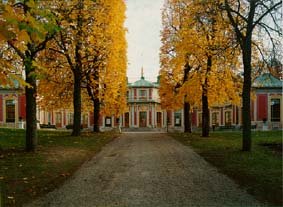The Chinese Pavilion is a small pleasure palace in the grounds
of Drottningholm. The first pavilion, a prefabricated building,
was erected here in 1753 as a birthday present to Queen Lovisa
Ulrika. It was built in a Chinese-inspired style which at that
time was the height of fashion in Europe. The present building
replaced it ten years later. The Chinese Pavilion combines the
European Rococo with exotic illusions to China. The lacquer-red
wall and sculptural decorations of the façades testify
to a close knowledge of Chinese architecture, but the main structure
of the building is emphatically European.
Unique collections of Chinese and Japanese decorative arts, mainly
from the 18th century, were assembled in this pavilion. An inventory
of the collections was compiled in 1777, when Drottningholm passed
into the hands of the State. Most of the items described in the
inventory still occupy their original places, making the Chinese
Pavilion one of the most authentic instances of 18th century European
chinoiserie.

A number of other pavilions, also in the Chinese style, adjoin the main building. One of them, the Confidence, is a dining room in which both the table and dumb-waiters were laid one floor below and then, on a signal being given from the dining room, hoisted up into position, enabling the royals to dine "en confidence" - without servants present.